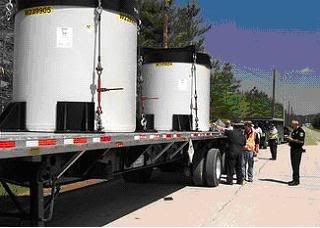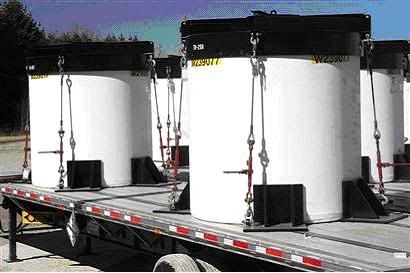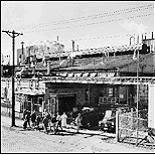do recovery between ohio and texas? hazmat comming
I am just spitballing here, but im guessing that on average- out of 2,500 trucks hauling the same load over 1,300 miles on the same route over a years time, one or two of them is bound to break down or screw up somehow some way. So watch out- one of you between
From many web news sites this is available. This excerpt is from: http://media.bonnint.net/apimage/CD10406062114.jpgRadioactive Waste From Ohio Texas

In this photo provided by Fluor Fernald, two steel canisters containing radioactive waste mixed with fly ash and concrete, on a truck bound for a storage site in Andrews,
http://www.msnbc.msn.com/id/7709778/
David Hinaman / Fluor Fernald via AP

Uranium byproduct waste from an
By BETSY BLANEY Associated Press Writer
(AP) - LUBBOCK, Texas-Trucks toting tons of Cold War-era uranium byproduct waste from a shuttered plant in Ohio will begin their 1,300-mile journey to Texas this month, taking a route chosen to minimize risk in case of an accident.
The
The material does not pose a great risk to humans, said Jeff Wagner, a spokesman for Fluor Fernald, the U.S. Department of Energy contractor cleaning up the former Fernald plant just outside
Should an accident occur, first responders would deal with it like a hazardous materials spill, he said. "From a radiation standpoint, it's not going to kill people," Wagner said, adding that there are greater risks from chemicals, gasoline and acids being carried on the nation's roadways.
That argument hasn't mollified environmentalists.
"The evidence out there is that just like any shipments, there's potential for accidents," Sierra Club spokesman Cyrus Reed said. "This material is so long lasting, and the results aren't necessarily imminent but they're more chronic in nature."
Visionary Solutions, LLC, an Oak Ridge, Tenn.-based company, will transport the radioactive waste, but Fernald is responsible for preparing the material before it's loaded onto flatbed trucks.
In 1998, DOE inspectors reported that Fernald failed to provide strong, tight containers and proper supervision to the waste transport program when moving radioactive waste to the DOE's Nevada Test Site just outside
Since then, shipping containers have been redesigned, quality control is more rigorous and there is increased focus on transportation issues, Wagner said.
But in March 2002, 70 mph winds just outside
The material, which is used for calibrating instruments and analyzing samples that might contain radioactive materials, was going to the Idaho National Engineering and Environmental Laboratory near
In the latest shipments, at least two Texas-bound trucks will leave
The route was chosen for travel time, distance and population along the way to minimize the risk, Wagner said. The trucks will primarily use interstates and they will travel around
Dallas-based Waste Control Specialists won a $7.5 million contract from Fernald in late April to store the waste - two months after state officials granted the company a license amendment that expanded the site's storage capacity to 1.5 million cubic feet - nearly five times its current size - making it eligible to accept the
The Sierra Club has requested a hearing to contest the license change. A hearing before an administrative judge in
Waste Control also seeks a license to dispose of the
http://www.stltoday.com/stltoday/news/stories.nsf/stlouiscitycounty/story/1D6508C16E54619B86257016000F68B5?OpenDocument
___________________________________________________________________________
This picture from October 1954 shows the Mallinckrodt Chemical Works plant at
(Post-Dispatch file photo
Radioactive waste will roll through area
Of the Post-Dispatch
|
Beginning Monday and extending through the end of the year, trucks loaded with thousands of tons of radioactive waste will pass through the
More than half of the waste will be making its second visit here. It came from the Mallinckrodt Chemical Works on the riverfront just north of downtown. Mallinckrodt, an atomic-age pioneer, altered the course of World War II by developing a way to purify uranium to the grade needed to make the atomic bomb.
After the war - in the 1950s - 6,000 tons of radioactive byproducts from the processing were shipped to a uranium processing plant northwest of
The department has chosen a temporary site in
Radiation coming from radioactive waste can cause cancer and genetic damage. Experts have long differed on how much exposure is dangerous. The waste coming from
Unconvinced is Kay Drey, a local activist and board member of the Washington-based Nuclear Information and Resource Service. She notes the irony of having the waste return to the
"They're moving from one temporary disposal facility in this massive attack on our highways to another temporary facility, and with no permanent place to go - and placing people at risk ... everywhere along the way," said Drey, of
The contractor in charge of the move, Fluor Fernald, also would prefer to ship the waste to a permanent site. But spokesmen for the company said the material could be moved safely.
"You always hate to speculate when it comes to what's vulnerable out on the road, but we'll argue there are things that are traveling across the interstate every day that would make more of a statement than a concrete block in a steel casing," said Jeff Wagner of Fluor Fernald.
"Everything we can do from a personal health and safety standpoint is being considered on this, and certainly the same holds true for environmentally."
15 trucks a day
The move will begin with one truck taking to the highway Monday. Eventually, though, Fluor Fernald plans to move 15 trucks per day, with each truck carrying two 20,000-pound containers of encased waste. The trucks will run seven days a week through December. In all, Fluor Fernald expects to move 4,000 containers, said Dennis Carr, the project director.
The containers, riveted shut when full, are made of half-inch-thick carbon steel and measure 6 1/2 feet tall and 6 feet in diameter. Empty, each weighs 4,000 pounds.
In each will be a combination of radioactive waste, concrete and flyash - a fine black ash produced in a coal-fired boiler plant, according to Wagner. Radioactive waste from two of Fernald's silos will make up about 20 percent of each container, with concrete and flyash making up the other 80 percent, Wagner said. The waste - byproducts of ores that were exceptionally rich in uranium from the former
The trucks will be outfitted with global positioning systems, and authorities who would respond to possible emergencies involving the shipments have been informed of what is coming their way, Carr said.
"There's no expectation of a problem, but in the event that there is, we're prepared to deal with it," he said.
Lee Sobotka, a
But if Fluor Fernald takes no shortcuts in preparing and packaging the waste, risks to public safety while the waste is in transit are low, Sobotka said.
Sobotka would also prefer to see the material delivered to a permanent site.
"It's not an ultimate solution," Sobotka said. "As a scientist, do I wish that there was a better plan and that it was being vitrified? Yes. Do I wish it was going to its final resting place? Yes. But the plague of trying to do everything perfect is paralysis."
Sierra Club suit
Cyrus Reed, a lobbyist for the Lone Star chapter of the Sierra Club, would rather see Fluor Fernald's plans paralyzed. The chapter has appealed a decision earlier this year that paved the way for Dallas-based Waste Control Specialists to accept the waste, a move that resulted in a $7.5 million contract for the company.
A hearing for the appeal is scheduled for July 11 - well after the shipments are under way.
"They're jumping the gun," Reed said. "Waste is being moved before we've even had a hearing."
Meanwhile, Waste Control Specialists is hoping for another change in its license - one that would allow it to permanently dispose of the radioactive materials as well, said George Dials, the firm's president and chief operating officer.
As it stands, the waste can remain at the
"We would have loved to go immediately to a disposal facility, but that option was not open," Wagner said. "At least you're getting the material off-site, which is certainly a step in the right direction in order to be able to finish the Fernald cleanup."
Drey vehemently disagrees. She suspects Fluor Fernald is acting quickly due to extra money it will receive depending on when the cleanup is done. The Department of Energy has a target date of
Overall, including costs accrued since the 1989 plant closing, the Department of Energy is expected to spend $4.4 billion on the cleanup, Wagner said.
Whatever the reasons behind the shipments to begin this weekend, Drey would like to see them stalled until a better solution is developed.
"What's the rush if it's been there for 50 years?" Drey asked. "It could go back again, it really could, as crazy as it sounds. We have no idea."
Reporter Elizabethe Holland
E-mail: eholland@post-dispatch.com
Phone: 314-340-8259
Note* Bottom photo credit: These containers, made of half-inch-thick carbon steel, will transport radioactive waste from


0 Comments:
Post a Comment
<< Home